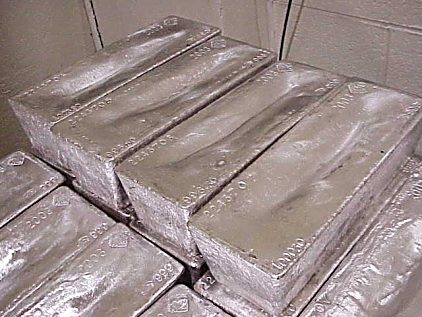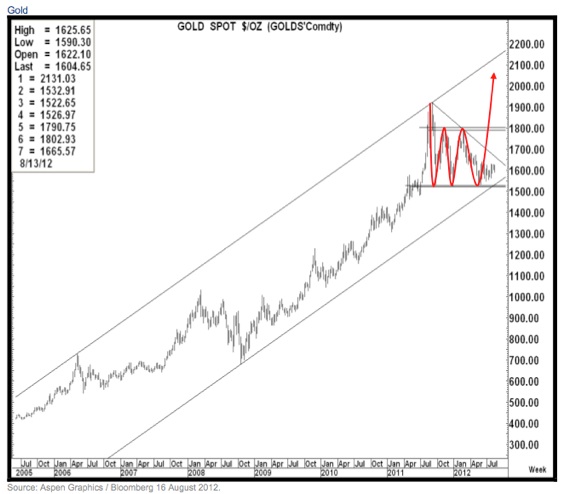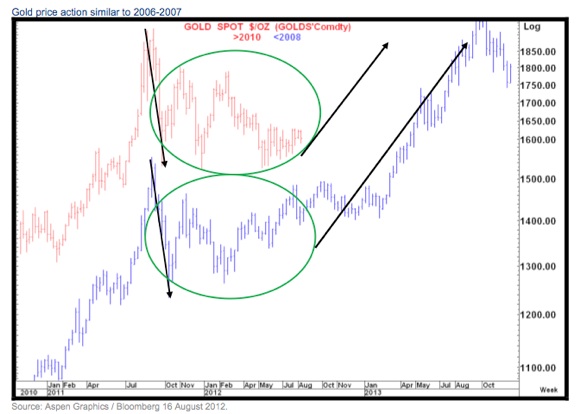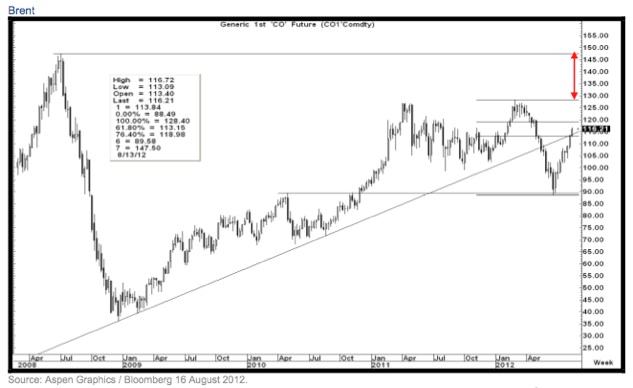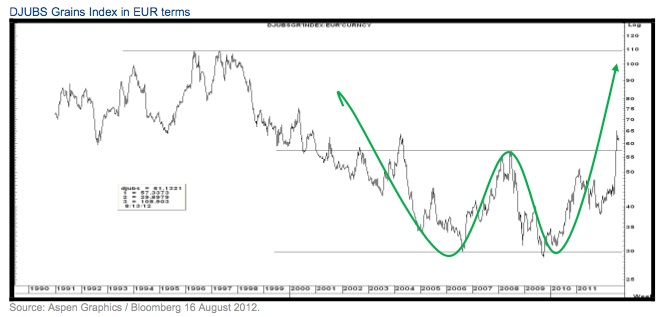Timing & trends
Knowing that it’s very likely that Gold and Silver have bottomed, we feel it is time to look at the charts and assess what may or may not be in store over the next year or two.
Gold has consistently made impulsive advances that were digested by multi-quarter corrections and eventually followed by a breakout and new impulsive advance. Following the last major breakout in late 2009, Gold enjoyed an extended impulsive advance that lasted two years. Previous impulsive advances lasted less than a year. Gold, having bottomed, remains well entrenched in another consolidation that is 12 months old. As we can see from the chart, previous consolidations lasted 16 to 20 months.
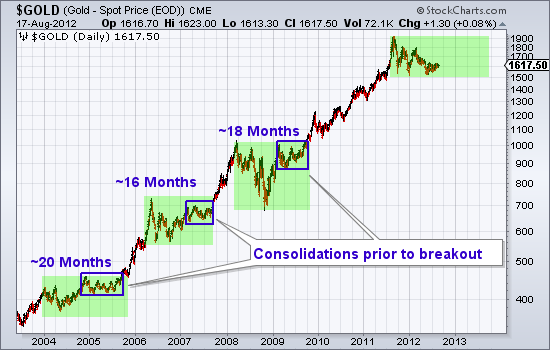
It is important to note that previously Gold, within a year was able to rally back near the recent impulsive high. In other words, Gold is currently in a much weaker state relative to past consolidations. Gold will need to rally back to $1800 or $1900 and that would be followed by a multi-month consolidation that would lead to a breakout. Conservatively speaking, over the next 12 months we could see a rally back to $1900 and a final consolidation.
Meanwhile, Silver continues to consolidate and digest the two and a half year advance from $8 to $49. Predictions of $60 or $70 Silver are absurd and fail to account for the lengthy consolidation that is needed to reduce supply and position the market for not only a retest of $50 but an actual breakout. Silver is a commodity with real world supply and demand dynamics. It will be a while before producers won’t sell for $35-$36 and before buyers consider $35 a bargain. That being said, the near and medium term outlook is quite compelling. Longer-term, the market is in a giant cup and handle pattern (dating back to the high in 1980) and this correction and consolidation is the handle. A powerful breakout past $50 in, say 2014, could push Silver towards its bubble phase.
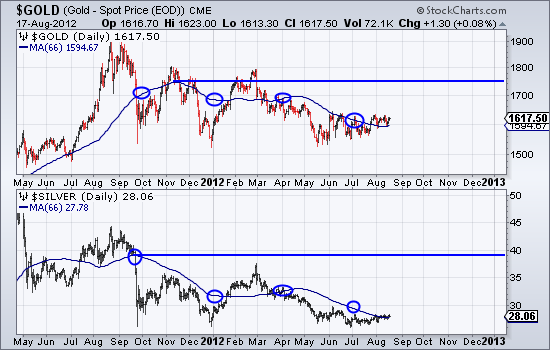
The fact that Gold and Silver are unlikely to break to new highs anytime soon hardly deters me in my bullish enthusiasm for select gold and silver stocks. Key word being select. I’m not bullish on every mining company but I digress. In the chart below I use a 66-day moving average to plot an average quarterly Gold and Silver price. I also circle the moving average at the end of quarters.
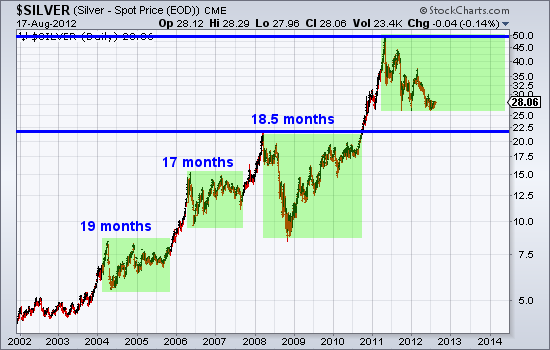
Note that the quarterly high prices for Gold and Silver are roughly $1750 and $39 and far off from the 2011 highs. The quarterly averages are starting to turn up. Well run companies with production increases could very well move to new highs when Gold returns to $1750 and Silver moves past $35. We do think most of the Gold and Silver shares can breakout to new highs ahead of the metals. In other words, the mining shares at large will ultimately challenge for a breakout ahead of Gold and Silver reaching new all time highs. If you’d be interested in our professional guidance and uncovering the producers and explorers poised for big gains, then we invite you to learn more about our service.
Good Luck!
Jordan Roy-Byrne, CMT
Jordan@TheDailyGold.com“>Jordan@TheDailyGold.com
Market psychology: One of my all-time favorite market quotes is from the 1987 movie Wall Street wherein Gordon Gekko declares that, “Money itself isn’t lost or made, its simply transferred from one perception to another.” Well perceptions have certainly changed…three months ago the market was very worried that the European financial crisis would spin out of control with contagion hitting all global markets…now fear is greatly reduced…especially since Draghi made his famous, “Whatever it takes,” statement on July 26…and that change in perception has shown up across asset classes.
Stocks: since the Key Turn Date and Key Weekly Reversal of June 4 theDJI has closed higher 9 out of 11 weeks, is up 1175 points (~10%) and closed this week at its highest weekly close since 2007. Since Draghi’s comments the major North American stock indices have risen ~5%, the German DAX is up ~11%, the UK FTSE is up ~7%, while Spanish and Italian stock indices are up ~25%!

VIX: the “fear” index, closed this past week at a 5 year low down ~50% from its June 4 Key Turn Date.

US and CAD interest rates: have risen sharply across the curve since Draghi’s comments while Spanish and Italian bond yields have fallen sharply.
Gold: implied volatility is near its lowest point of the past10 years…gold has been trading in a narrower and narrower range over the past 4 months…breakout ahead?

Crude: WTI hit a low of $78 on June 28…it’s now $96 up ~23%…Iran/Israel fears?
TSE: up 200 points on the week, up 755 (~6.5%) points since the June 4 lows.
Apple: hit a new all-time-high this week (up ~13% since Draghi’s statement) with a market cap of over $600 Billion. To put that market cap in perspective….it’s ~$200 Billion more than 2nd place Exxon, it’s double the market cap of third place Microsoft…double the combined market cap of Canada’s top 5 banks.
Royal Bank: closed at a 3 month high up ~16% from the June 4 lows…the broad US Bank Share Index is up ~15% from the June 4 lows.
CAD: is up over 5 cents from its June 4 lows at a 3 month high above 101.

Volume: share trading volume has been on a declining trend for the past few years and 2012 is on track to register the lowest annual volume in 15 years. This past week appears to be the lowest weekly volume in years…and it felt like it…summer doldrums in spades! (As an aside…the declining trading volumes and low interest rates are a double-whammy hitting the stock brokerage business…brokerage firms are losing money…expect consolidation across the industry.) If there is an Achilles heel to the recent stock market gains it may be that the rally has been on very light volume.
Money is mobile: Prices change as perceptions change…and as perceptions change money moves from one place to another…it moves from the center to the periphery…and back…from the “old reliable” to the exotic…and back…from low beta to high beta…and back…from New York to emerging markets…and back…from low yields to high yields…and back. A change in perceptions shows up across asset classes…in some sooner than others…in some more dramatically than others…by watching how these asset classes move relative to one another you can get a sense of how market perceptions are changing…you can find trading opportunities that “go with the flow.”
Trading: my theme for the past several weeks has been that, “this market wants to go higher.” I will maintain long positions in




